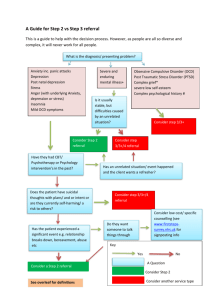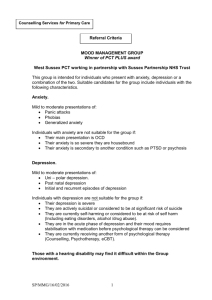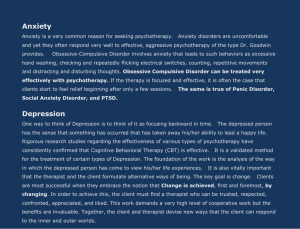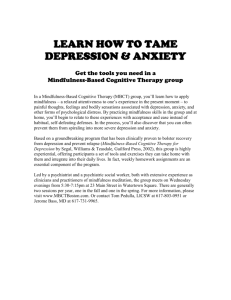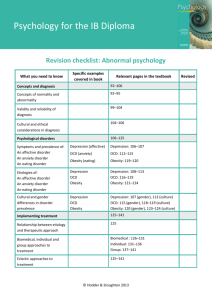Feeling anxious sometimes is perfectly normal
advertisement
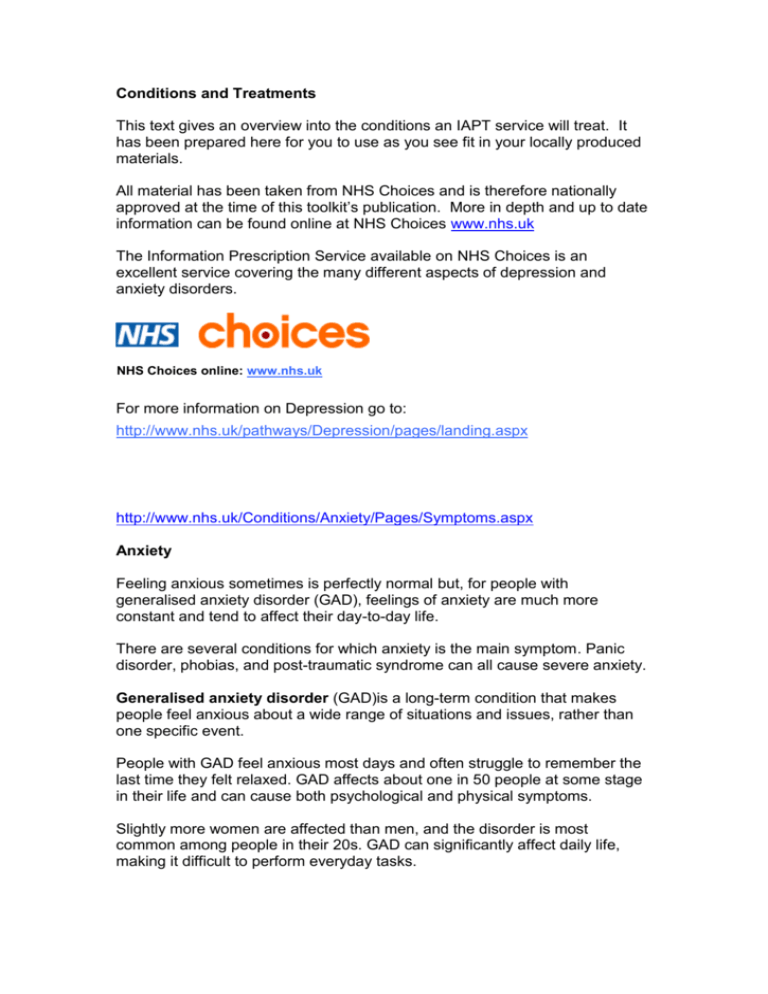
Conditions and Treatments This text gives an overview into the conditions an IAPT service will treat. It has been prepared here for you to use as you see fit in your locally produced materials. All material has been taken from NHS Choices and is therefore nationally approved at the time of this toolkit’s publication. More in depth and up to date information can be found online at NHS Choices www.nhs.uk The Information Prescription Service available on NHS Choices is an excellent service covering the many different aspects of depression and anxiety disorders. NHS Choices online: www.nhs.uk For more information on Depression go to: http://www.nhs.uk/pathways/Depression/pages/landing.aspx http://www.nhs.uk/Conditions/Anxiety/Pages/Symptoms.aspx Anxiety Feeling anxious sometimes is perfectly normal but, for people with generalised anxiety disorder (GAD), feelings of anxiety are much more constant and tend to affect their day-to-day life. There are several conditions for which anxiety is the main symptom. Panic disorder, phobias, and post-traumatic syndrome can all cause severe anxiety. Generalised anxiety disorder (GAD)is a long-term condition that makes people feel anxious about a wide range of situations and issues, rather than one specific event. People with GAD feel anxious most days and often struggle to remember the last time they felt relaxed. GAD affects about one in 50 people at some stage in their life and can cause both psychological and physical symptoms. Slightly more women are affected than men, and the disorder is most common among people in their 20s. GAD can significantly affect daily life, making it difficult to perform everyday tasks. Panic disorder causes people to have feelings of anxiety, stress and panic at any time, usually for no obvious reason. Panic attacks cause a rush of intense psychological and physical symptoms, which may include an overwhelming sense of fear, apprehension and anxiety. Physical symptoms, such as nausea, sweating, trembling and a sensation of irregular heart beats (palpitations) may also occur. A panic attack can be very frightening and intense but is not dangerous and will not cause physical harm. At least one person in 10 experiences occasional panic attacks, usually triggered by a stressful event or situation, but people with panic disorder have recurring and regular attacks, often for no apparent reason. Some people may have one or two attacks each month, while others may have several attacks a week. In the UK, about one person in 100 has panic disorder and it is around twice as common in women as it is in men. Phobia is a constant, extreme or irrational fear of an animal, object, place or situation that would not normally worry most people. It is characterised by an overwhelming need to avoid any contact with the specific cause of the anxiety or fear. Even the thought of coming into contact with the cause of the phobia causes anxiety or panic. Everyday life is not affected much if it is unlikely that you will come into contact with the object of your phobia (for example, snakes) but agoraphobia and social phobia can make it very hard to lead a normal life. Simple phobias ares about a single object, situation or activity. Common examples are a fear of insects, heights, snakes, enclosed spaces, dentists or flying. Complex phobias, like agoraphobia involve several anxieties, including fear of entering shops, crowds and public places, or of travelling in trains, buses or planes. It also includes anxiety of being unable to escape to a place of safety, usually home. Social phobia is another complex phobia involving 1-2% of men and women who fear social or performance situations, such as a wedding or public speaking in case they embarrass themselves or are humiliated in public. In extreme cases, some people are too afraid to leave their home. Obsessive compulsive disorder (OCD) is one of the most common mental health conditions affecting an estimated 1-3% of adults and 2% of children and teenagers. It is a chronic condition usually associated with both obsessive thoughts and compulsive behaviour. An obsession is an unwanted thought, image or urge that repeatedly enters a person’s mind. A compulsion is a repetitive behaviour or mental act that a person feels compelled to perform. A person with OCD gets no pleasure from their compulsive behaviour but feels they need to carry out their compulsion to prevent their obsession becoming true. For example, a person who is obsessed with the fear that they will catch a serious disease may feel compelled to have a shower every time they use a public toilet OCD symptoms can begin at any time, including childhood, but in men usually begin in adolescence and in women usually start in the early 20s. Causes are unknown but symptoms can range from mild to severe. Some people with OCD will spend around one hour a day engaged in obsessive compulsive thinking and behaviour, while for others, the symptoms completely dominate their life. The causes of OCD are unknown. With treatment, the prognosis for OCD is good. Some people achieve a complete cure and others can reduce their symptoms and achieve a good quality of life. Cognitive behavioural therapy (CBT), can be very successful in helping many people with OCD. Post-traumatic stress disorder (PTSD) is a psychological and physical condition that can be caused by extremely frightening or distressing events, such as military combat, natural disasters, serious accidents, terrorist attacks, violent deaths, and personal assaults, such as rape, or other situations in which the person felt extreme fear, horror, or helplessness. It affects around 5% of men and 10% of women some time in their life and can happen at any age. About 40% of people with PTSD develop it as a result of someone close to them suddenly dying. Someone with PTSD often relives the experience through nightmares and flashbacks, and has difficulty concentrating and sleeping, feeling isolated and detached. from life. These symptoms can be lasting and severe enough to impair the person's daily life significantly. Symptoms usually develop immediately or within three months of a traumatic event but, occasionally, they do not begin until years later. PTSD has been called shell shock or battle fatigue syndrome because it first came to prominence in the First World War, with soldiers' memories of the trenches. Now, it is recognised that traumatic events outside conflict situations can have similar effects. Stress Stress is the way you feel when under pressure to do something. A little bit of pressure can be productive, give you motivation, and help you perform better at something - but too much or prolonged pressure can be unhealthy and lead to physical, mental and emotional problems. Everyone reacts differently to stress, and some people may have a higher threshold than others. In the UK, anxiety and depression are the most common mental health problems, and the majority of cases are caused by stress. When faced with a situation that makes you stressed, your body releases chemicals, including cortisol, adrenaline and noradrenaline, which invoke the 'fight or flight' feelings that help us deal with the situation. But in a situation where fighting or escaping is impossible, such as being on an overcrowded train, these chemicals are not used and can increase blood pressure, heart rate and sweating as well as releasing fat and sugar into the bloodstream and preventing the immune system functioning properly. Depression For people with depression, the usual feelings of sadness that we all experience temporarily remail for weeks, months and years. Depressed people may fee; worthless, hopeless and constantly tired. Daily life can be affected so that they cannot work normally, don’t want to be with family and friends and stop enjoying the things they usually do. In milder cases, people can probably carry on although they find everyday tasks difficult but in severe cases people may find their feelings so unbearable that they start thinking about suicide. About one in 10 of us develops some form of depression in out lives and one in 50 has severe depression. It affects families and friends as well as the depressed person. Studies suggest women are about twice as likely to have depression as men but this may be because women are more likely to seek help. Some studies suggest depression is more likely as we get older and it’s more common among people who face difficult social and economic circumstances. Depression isn’t a sign of weakness, it’s a chronic condition that may require long-term management or treatment. Some people only have depression once but many people have repreated episodes. With the right treatment and support, most depressed people make a full recovery so it is important that people who think they may be deptessed seek help from their GP. Causes of depression are complex and may increase as a result of A stressful life event such as bereavement or relationship breakdown Diagnosis of a chronic or life-threatening illness Being vulnerable to depression due to low self esteem or being overly self-critical Having recently given birth, because of hormonal and physical changes Being cut off from family and friends Drinking excessively, using drugs or substance abuse Effective treatment for depression has been identified by the National Institute for Health and Clinical Excellence (NICE). For people with mild depression, further assessment is required, usually within two weeks as the patient may recover without intervention. Anti-depressants are not recommended at this stage but guided self help, such as computerised cognitive behavioural therapy, should be considered. For people with mile to moderate depression, psychological treatments should be considered – mainly cognitive behavioural therapy (CBT), perhaps with antidepressant drugs. Selective serotonin reuptake inhibitors (SSRIs) should be considered over tricyclic antidepressants because of better safety and fewer side effects. Patients should be informed that withdrawal symptoms may occur when stopping, missing a dose or reducing the dose. For people with severe depression, a combination of antidepressants and individual CBT should be considered as combining the treatments is more effective than using them on their own. Cognitive behavioural therapy helps you understand your current thoughts and behaviours and how they’re affecting you. It recognises how events in your past may have shaped you but concentrates mostly on how you can change the way you think, feel and behave in the present day. It is the most well-known and best-studied talking treatment for depression and is used to treat all types of depression. Computerised CBT can be delivered on a personal computer, via the internet or by telephone using voice-response systems. It can help people who don’t want to take antidepressants and may be useful for those who have a phobia about going out because it can be used at home. Inter-personal therapy is sometimes used to treat people with mild to moderate depression. It originated from the work and theories of 1930's psychiatrist Harry Sullivan who suggested that patients’ interpersonal contact with others might help to shed light on their mental disorders. Interpersonal therapy does not belong to any particular school of psychotherapy, but is based on the experimental work of individual practitioners. The approach is concerned with reducing the symptoms of depression and improving the client's interpersonal interaction with others. Couples therapy is sometimes used to treat people with mild to moderate depression where relationship issues are a main factor. Couples will take part in between 16 and 20 sessions spread over four to six months.

